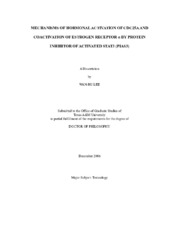| dc.description.abstract | The estrogen receptor (ER) is a ligand-activated transcription factor that regulates
gene expression. The classical mechanisms of nuclear ER action include ligand-induced
dimerization of ER which binds estrogen responsive elements (EREs) in promoters of
target genes. In addition, non-genomic pathways of ER action have also been identified
in breast cancer cells.
Cdc25A is a tyrosine phosphatase that catalyzes dephosphorylation of
cyclin/cyclin-dependent kinase complexes to regulate G1- to S-phase cell cycle
progression. Cdc25A mRNA levels are induced by 17β-estradiol (E2) in ZR-75 breast
cancer cells, and deletion analysis of the Cdc25A promoter identified the -151 to -12
region as the minimal E2-responsive sequence. Subsequent mutation/deletion analysis
showed that at least three different cis-elements were involved in activation of Cdc25A
by E2, namely, GC-rich Sp1 binding sites, CCAAT motifs, and E2F sites. Studies with
inhibitors and dominant negative expression plasmids show that E2 activates Cdc25A
expression through activation of genomic ERα/Sp1 and E2F1 and cAMP-dependent
activation of NF-YA. Thus, both genomic and non-genomic pathways of estrogen action
are involved in induction of Cdc25A in breast cancer cells.
The PIAS family was initially identified as cytokine-induced inhibitors of STATs
which contain several conserved domains involved in binding to other nuclear
coactivators. In this study we have investigated coactivation of ERα by PIAS3 in breast
cancer cell lines transiently cotransfected with the pERE3 constructs which contain three
tandem EREs linked to a luciferase reporter gene. PIAS3 coactivated ERα-mediated transactivation in cells cotransfected with pERE3 and wild-type ERα. In contrast to many
other coactivators, PIAS3 also enhanced transactivation of ERα when cells were
cotransfected with the TAF1 ERα mutant. In addition, PIAS3 does not interact with
activation function 2 (AF2) domain of ERα in a mammalian two-hybrid assay. These
data indicate that coactivation of ERα by PIAS3 was AF2-domain independent. Analysis
of several PIAS3 deletion mutants showed that the region containing amino acids 274 to
416 of PIAS3 are required for coactivation suggesting that the RING finger domain and
acidic region of PIAS3 are important for interactions with wild-type ERα. These results
demonstrate that PIAS3 coactivated ERα and this represents a non-classical
LXXLL-independent coactivation pathway. | en |


